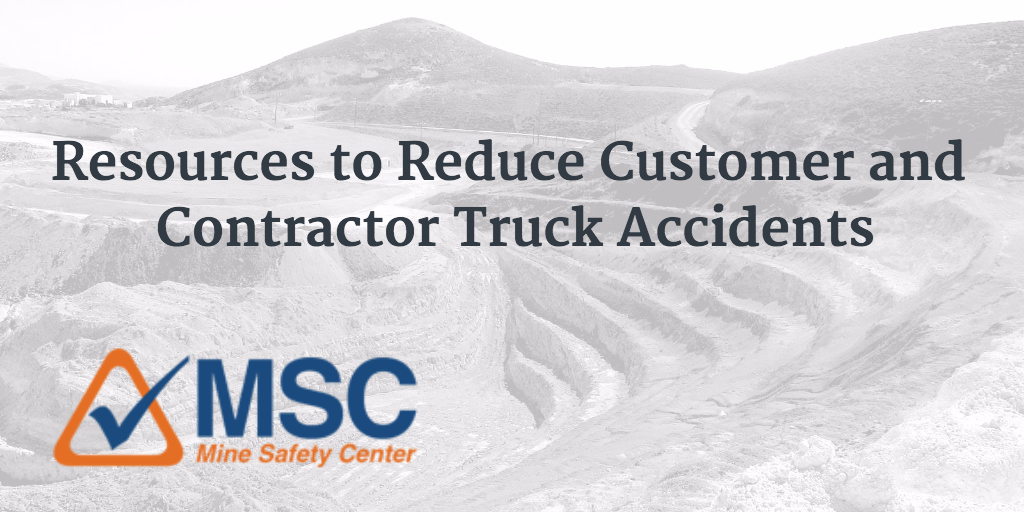Mining Truck Accidents Can Be Reduced
Have contractors or customers caused mining truck accidents or a near miss on your site? Are aggregate haulers climbing on their trucks at your mine? Do drivers outside their trucks pose a hazard at your mine? Do you have difficulty managing these outside truckers?
Following established rules and procedures is essential to reduce mining truck accidents and other unsafe incidents. These rules and procedures also apply to customers and contractors but are sometimes forgotten because these drivers are not on a mine as often as mine employees.
The Mine Safety Center has teamed up with CalCIMA to produce free materials to teach a few simple ways to stay safe on a mine. “The training materials include signs that will warn drivers of the most common customer truck hazards at mine sites,” said Mike Herges, safety manager at Graniterock and a co-chair of CalCIMA’s Safety & Health Committee. “We hope mine operators embrace these warning signs and they become the standard at all mines,” added Herges. The training materials include a video, postcard, and brochure that incorporate the warning and caution signs. They provide operators a variety of formats to reach drivers, brokers, and fleet managers.
MSHA Part 50 Compliance Will Be Heavily Scrutinized
MSHA Part 50 enforcement will be significantly increased starting today. In a previous blog we discussed how MSHA will increase the number of inspectors and inspections at metal/non-metal mines with a heightened focus on smaller “mom and pop” mines.
In recent weeks, MSHA Part 50 enforcement of Accident Reporting has also increased. MSHA believes there has been underreporting of accidents and injuries. To back up these claims, inspectors have begun to go through workman’s compensation paperwork. If MSHA finds a serious accident that wasn’t reported in 15 minutes they will issue a ticket of $5000 to $60,000.
What accidents or injuries fall under the MSHA Part 50 Immediate notification requirement? According to 30 C.F.R. § 50.10 operators “shall immediately contact MSHA at once without delay and within 15 minutes at the toll-free number, 1-800-746-1553, once the operator knows or should know that an accident has occurred involving:
- A death of an individual at the mine;
- An injury of an individual at the mine which has a reasonable potential to cause death;
- An entrapment of an individual at the mine which has a reasonable potential to cause death; or
- Any other accident.
The language “any other accident” is ambiguous but MSHA goes on to define an accident as:
- A death of an individual at a mine;
- An injury to an individual at a mine, which has a reasonable potential to cause death;
- An entrapment of an individual for more than 30 minutes or which has a reasonable potential to cause death;
- An unplanned inundation of a mine by a liquid or gas;
- An unplanned ignition or explosion of gas or dust;
- In underground mines, an unplanned fire not extinguished within 10 minutes of discovery; in surface mines and surface areas of underground mines, an unplanned fire not extinguished within 30 minutes of discovery;
- An unplanned ignition or explosion of a blasting agent or an explosive;
- An unplanned roof fall at or above the anchorage zone in active workings where roof bolts are in use; or, an unplanned roof or rib fall in active workings that impairs ventilation or impedes passage;
- A coal or rock outburst that causes withdrawal of miners or which disrupts regular mining activity for more than one hour;
- An unstable condition at an impoundment, refuse pile, or culm bank which requires emergency action in order to prevent failure, or which causes individuals to evacuate an area; or, failure of an impoundment, refuse pile, or culm bank;
- Damage to hoisting equipment in a shaft or slope which endangers an individual or which interferes with use of the equipment for more than thirty minutes; and
- An event at a mine which causes death or bodily injury to an individual not at the mine at the time the event occurs.
Additionally, “injuries not related to one of the twelve types of accidents mentioned in 30 C.F.R. MSHA Part 50 (50.2(h)), such as ordinary sprains, strains, minor cuts, minor burns, bruises or other injuries that are not life-threatening, do not require immediate notification. These types of injuries should be reported via the 7000-1 form under MSHA Part 50 regulations.”
What can you do to stay MSHA compliant and protect your company?
First and foremost everyone on your site needs to be prepared. Put standard operating procedures in place and practice those procedures. Everyone on site, including contractors, must know the physical address of the mine so they can call 911 and bring help as soon as possible.
Second, all employees must know the next steps to take in the event of an accident. Do they have first aid training? Do they have a first aid kit? Will they be able to care for someone until paramedics arrive?
Finally, you need to follow regulations and report all accidents as defined by MSHA Part 50 within 15 minutes of their occurrence.
If you have questions regarding accidents you may have had, you can email MSC at sales@minesafetycenter.com or call 602-956-6959 ext. 23. We may be able to help.
Mine Safety Enforcement To Be “Beefed Up”

In the wake of five metal / non-metal fatalities in the last three weeks, including 3 on August 3rd, the Mine Safety and Health Administration, or MSHA, announced that inspectors will step up enforcement beginning next week.
During a hastily arranged conference call of stakeholders Wednesday, agency administrator Joe Main lamented the fact that, since October, 2014, 38 miners and 14 contractors have lost their lives at their workplaces.
During the call, MNM administrator Neal Merrifield said that 17 coal inspectors are being switched over to work in the MNM segment. Also, Merrifield has authorized the hiring of an additional 21 inspectors. MSHA also indicated that those mines found to not be following mine safety best practices associated with the standards found to have been relevant in the fatalities will be subject to impact inspections. At the call’s conclusion, Main said he realizes that many small mines are involved in the problem. This would indicate a heightened focus on “mom and pop” outfits.
In a letter to the mining community, MSHA’s Joe Main said, “To reverse this unacceptable trend, the Mine Safety and Health Administration is stepping up enforcement efforts and intensifying outreach and education throughout the country.”
Key points:
- MSHA will increase the number of inspectors and inspections at metal/non-metal mines, beginning on 10/1. These will include “walk & talk” meetings with operators and miners.
- Heightened focus on smaller “mom and pop” mines
- MSHA emphasizes the need for thorough workplace exams each shift that are performed by experienced and trained examiners, per the recent program policy letter.
- Inspectors will be closely scrutinizing workplace exam paperwork.
- MSHA re-iterates the importance of safety and health programs, per Joe Main’s May 21 letter to the mining community.

